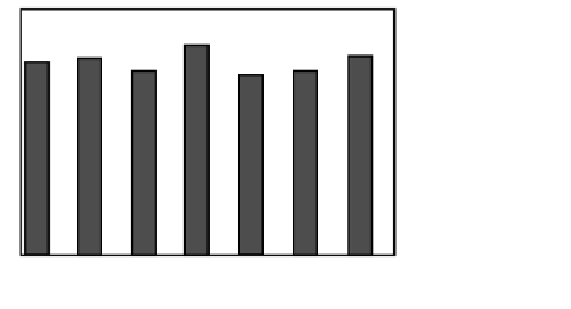Biology Reference
In-Depth Information
7
6
5
4
Control
Recombinant
3
2
1
0
1 2 3 4 5 6 7
Insect Number
FIGURE 6.3
Number of
T. cruzi
in the hind gut of
Rhodnius prolixus
in control (black bars),
R. prolixus
carrying native symbiotic
Rhodococcus rhodnii
in the hind gut, and (hatched bars) recombinant group where
Rhodnius prolixus
which expresses the gene for cecropin
A peptide. Unstained metacyclic trypomastigotes were counted using a Neubauer hemocytometer, and the
count number is expressed as log
carry a genetically modiÝed
Rhodococcus rhodnii,
All values are the mean of four measurements. No trypanasomes were
seen in recombinant insects 2, 3, 4, 6, and 7, and the hatched bars in these columns indicate that counts were
performed. [Adapted from Durvasula, R.V., Gumbs, A., Panackal, A., Kruglov, O., Aksoy, S., MerriÝeld, R.B.,
Richards, F.F., and Beard, C.B. (1997).
10.
Proc. Natl. Acad. Sci. U.S.A.
94:
3274Ï3278.]
plasmid was quite stable in the absence of antibiotic selection, with a 0.5% loss per generation of
Rhodococcus rhodnii
,
where concentrations of the bacteria increase rapidly only after blood meals and are stable during
interim periods, plasmid stability appears to be much greater.
These studies were the Ýrst demonstration of paratransgenic expression of foreign genes in a
disease-transmitting arthropod with reduction in vector competence.
, under
in vitro
continuous culture conditions. In the gut of
Rhodnius prolixus
ANTIBODY EXPRESSION
Cecropin A and related immune peptides hold promise as effector molecules in a paratransgenic
strategy. However, these compounds lack speciÝcity for
and exhibit bactericidal activity
against a variety of Gram-negative bacteria that may be found in reduviid bugs under Ýeld condi-
tions. Furthermore, resistance to such peptides among target populations of
T. cruzi
is likely to
occur over time. The need for another class of effector molecules that could be expressed concur-
rently or sequentially with immune peptides led to work with single-chain antibodies.
The use of antibodies for therapeutic and diagnostic purposes has gained prominence in the
past decade. Immunoglobulins have excellent target speciÝcity, but their clinical applications are
limited because of short circulating half-lives and their need for associated effector functions.
Biomolecular engineering technology has provided the tools to design high-afÝnity-based
reagents for immunotherapeutic applications. Several diseases, such as rheumatoid arthritis,
CrohnÔs disease, and cancer, are now being approached by antibody treatments. In recent years,
the Food and Drug Administration has approved the Ýrst engineered antibodies for cancer therapy
(Rituxan for non-Hodgkins lymphoma, Herceptin for breast cancer). These immunotherapeutic
antibodies are designed to include the Fc domain for prolonged serum half-life and complement
mediated effects. Engineered antibodies may be designed to have various structural changes that
include reduction in size to single-chain Fvs, dissection into minimal binding fragments such as
Vh domains, and rebuilding of scFvs into multivalent, high-avidity oligomeric scFvs (Huse et
al., 1989; Holliger et al., 1993). In recent years, through phage-display technology, it has become
possible to clone single-chain antibody-encoding genes that can be expressed in a variety of
T. cruzi





















